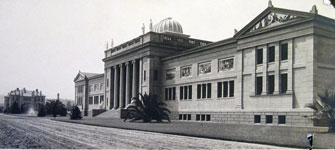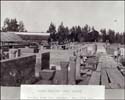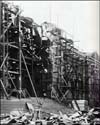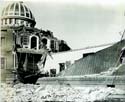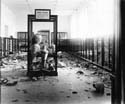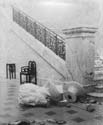|
Gallery | Campus Structures | Museum The Leland Stanford Junior Museum, located along the west side of Palm Drive, was the second project planned by the Stanfords to memorialize their son. A collector of antiquities and ethnological artifacts and a student of classical archaeology, Leland Jr. had hoped to one day open his own museum in San Francisco. The museum was Jane’s primary interest and provided an outlet for her energies, while her husband focused on the planning and design of the university. Consideration was given to building the museum in San Francisco for the benefit of the citizens, but ultimately the campus site was chosen. Even before the location of the museum was determined, the Stanfords purchased a number of significant collections of Greek antiquities, Cypriot pottery, and Korean and Northwest Coast Indian artifacts to add to the objects in Leland Jr.’s collection. American and European paintings, acquired by the Stanfords for their various residences, and works by Australian artists, donated by Leland Stanford’s brother, Thomas Welton Stanford, were added to what was described as a “universal survey” of world art.
The neoclassical building, commissioned by Mrs. Stanford, was modeled on the National Archaeological Museum in Athens, visited by Leland Jr. shortly before his death. Jane oversaw the design and construction, though Leland advised on important decisions, including the choice of architect and construction material. A domed central structure, with stepped-back wings, was constructed using a technique of embedding twisted iron rods with raised surfaces in concrete. Pioneered by Ernest Ransome, this method is the precursor of today’s reinforced concrete construction. The decision to use concrete as the building material, rather than cut stone, was made to speed construction work, since Jane insisted the museum be completed for the opening of the University. Although the structural work was finished by November 1891, the dampness of the concrete, which takes time to dry thoroughly, and other interior work delayed installation of the art exhibits. The museum finally opened to the public in 1894, a year after Leland Sr.’s death. In 1898 Jane commenced the expansion of the museum to reach the quadrangle form she had originally planned. The additions were constructed, not of reinforced concrete, but of unreinforced brick with a coating of cement to match the original building. By 1905, the museum was 200,000 square feet, making it the largest privately owned museum in the country, and Jane worked furiously to acquire collections to fill the vast spaces.
The original section of the Museum suffered relatively little damage in the earthquake, compared to the newer wings, which were largely ruined. The exhibits of pottery, Salviati glass, marble sculpture, and antiquities lay shattered throughout the galleries, though the collections in the Memorial Room and the Leland Stanford Room survived virtually intact. The scene inside the Museum was described as a “morgue of relics.” There was no doubt the Museum had suffered badly both in terms of structure and collections.
Learn more about the Museum on the Walking Tour.
Digital images from the Stanford University Archives represented on this site may be viewed freely. These images may not be reproduced or used for any purpose without permission. For permission requests please contact the Office of the University Archivist
Questions or comments? Email the Web Manager
|

